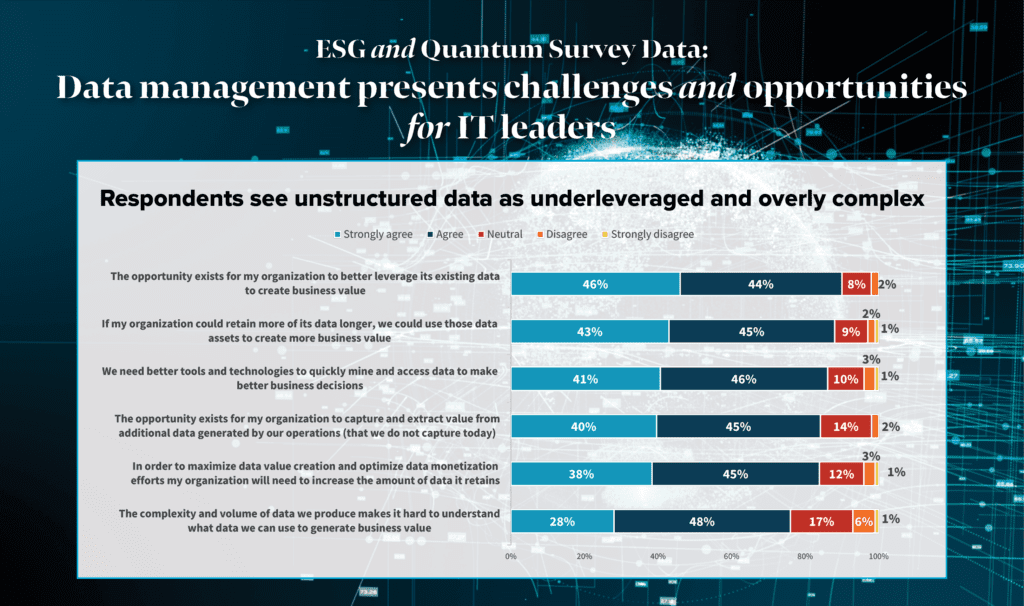From media companies to financial services organizations and even healthcare providers, enterprises are generating, processing and storing more data than ever. For most organizations, this means enterprise data management has risen to the top of enterprise and IT leaders’ agendas, with many trialing new approaches and tactics.
So, are businesses extracting maximum value from their data? Or are they being crushed under the weight of a rapidly advancing data avalanche? To find out, ESG Research and Quantum reached out to IT professionals (73%) and other business leaders (27%) in organizations with over a petabyte (PB) of unstructured data capacity deployed from industries such as technology, financial services, manufacturing, and business services.
Unstructured data is expanding at massive volumes and remains key to business growth. According to the survey, seven out of 10 management teams put their data at the core of growth. But there are key trends emerging that will have an impact on the success of capitalizing on this data moving forward.
Based on the survey responses, here’s what was learned about the data management challenges and opportunities facing enterprises in 2022.
Also read: Simplifying Data Management with Hybrid Networks
1. Data Management and Security Implications of Data Sprawl
Unsurprisingly, given the rise of the Internet of Things (IoT) and growing enterprise cloud use, most respondents said data in their organization was highly distributed and mobile. In fact, 78% of respondents said their organization regularly moves data between cloud, on-premises, and edge environments. And in terms of storage infrastructure, most organizations surveyed operate a hybrid cloud model—storing most data in the public cloud, with the rest remaining on-premises.
The resulting data sprawl can complicate enterprise data management. The vast majority (88%) of respondents said that highly distributed data acts as a barrier to implementing an end-to-end data strategy in their business. Additionally, regularly moving data between environments creates an ideal habitat for ransomware and cyberattacks, with 87% of respondents rating this as a significant concern.
Despite growing security concerns, just 6% of organizations have developed a viable air-gapped ransomware response strategy. This low figure is particularly surprising, given that two out of five respondents said their organization had fallen victim to a ransomware attack in the last two years. And an astounding 82% admitted to paying a ransom (of a median figure of $375k) to regain control of their data.

2. Finding a Storage Solution That Balances Cost With Performance
The growing quantity of data generated by organizations presents a serious challenge for IT leaders. Currently, IT leaders are struggling with finding the right balance between extracting maximum business value from data while storing it safely and cost-effectively. In fact, 76% of ESG Research and Quantum’s survey respondents reported being under pressure to store data for longer time periods than currently feasible and in a more cost-effective manner.
Interestingly, 88% of respondents said retaining more data for longer would be an avenue to creating greater business value in their organization. However, 38% also said they felt that the complexity and volume of data produced made it difficult to understand what data is useful and what isn’t.
What’s more, over half of respondents admitted to deleting data before it could create business value. Reasons given for this included security and compliance concerns (55%), cost (47%), and not being able to find a storage solution that offered the right balance between cost and performance (32%).
3. Opportunities for Enterprises to Improve Their Data Management
It’s clear that in most organizations there’s significant room for improvement in how data is managed. But with a different approach, organizations can better create value with their data.
Developing a data retention and destruction strategy
One way enterprises can do this is by implementing a formalized data retention/destruction strategy. Currently, nearly three-fourths of organizations surveyed don’t have one in place. Without a strategy, data is often retained unnecessarily, causing spiraling storage expense. Or at the opposite end of the spectrum, useful data is deleted without due process in order to save on storage costs.
Additionally, operating without a clear data retention/destruction strategy can add unnecessary complexity to the process of data deletion. When asked about complications around deleting data, 67% of respondents cited confusing cross-functional and distributed processes, while 37% struggled with obtaining approval from management.
Adopting new software tools
Another way enterprises can improve their data management strategy is by adopting new software tools built for the data age. For example, 89% of respondents said more automated storage tiering would bring them substantial savings. Meanwhile, 87% agreed they needed better technologies to quickly mine and access data for business decision-making.
Storing data for longer
Last but not least, it’s clear that across the board, businesses would benefit from storing their data for longer. This has several benefits. Almost two-thirds (65%) of survey respondents said their organization would be better equipped to recover from a cyberattack if they could retain their data for longer. Respondents also agreed that storing data for longer would empower data monetization (60%) as well as improve overall business decision-making (58%).
Overall, concerns around data retention, storage costs, and data sprawl all point to a need for more comprehensive and cost-effective enterprise data management solutions. Forward-thinking IT leaders should be open to evaluating alternative options to the public cloud, like tape and object storage, to enable them to extract maximum value from their data.
Read next: Best Data Management Platforms (DMP) 2021



